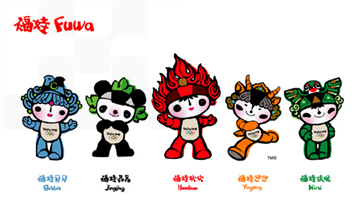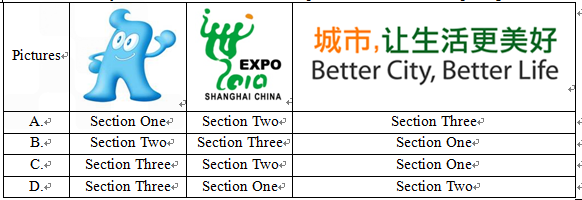
科目: 来源:广东省期末题 题型:阅读理解

查看答案和解析>>
科目: 来源:福建省期中题 题型:阅读理解
查看答案和解析>>
科目: 来源:安徽省期中题 题型:阅读理解
查看答案和解析>>
科目: 来源:江西省期末题 题型:阅读理解
阅读理解
Section One
The city is an accumulation (积累)of human civilization. Just as the American social philosopher
(哲学家) Lewis Mumford put it, it is a special system which, fine and compact(简洁的), has been
designed to preserve the fruits of human civilization. Many Western languages have developed their
versions of the term “civilization” from the same Latin (拉丁语的) word “civitas”(meaning “city”), and
it is by no means a coincidence(巧合). The city has played a significant role in the perfection of
order in human society.
Section Two
The emblem, showing the image of three people ? you, me, him/her holding hands together,
symbolizes the big family of mankind. Inspired by the shape of the Chinese character “世”
(meaning the world), the design conveys the organizers' wish to host an Expo which is of global
scale and which displays the various urban cultures of the world.
Section Three
Created from the inspiration of Chinese character “人”, the design roots deeply in Chinese culture.
It tells the world the eternal core (永恒的核心) and theme of Shanghai World Expo will be always
human. The mascot(吉祥物) “Haibao” will become the messenger for the theme of
World Expo 2010 Shanghai China “Better City, Better Life”.
The basic structure of the Chinese character “人” in which each stroke(一笔,一划) supports
each other also shows the concept that the beautiful life should depends on mutual-help. If the human
are willing to support one another, the harmony among human, nature, and society will be available.
Such an urban life will be nice.
Haibao’s confident smile is expressing his sincere greeting from China ? “World Expo 2010
Shanghai China welcomes you!”
1. Section One mainly tells us about ______.
A. the part cities play in human civilization
B. the development of the word “city”
C. why the Expo is held in Shanghai
D. where human civilization originated
2. The underlined word “it” in Section One refers to ______.
A. the civilization
B. the philosopher
C. the word
D. the city
3. Which correctly matches the sections with the pictures described in the passage?

4. The second paragraph in Section Three explains how the creation is connected with the _____ of
the Chinese word “人”.
A. story
B. meaning
C. shape
D. usage
查看答案和解析>>
科目: 来源:山东省期中题 题型:阅读理解
查看答案和解析>>
科目: 来源:福建省期中题 题型:阅读理解
查看答案和解析>>
科目: 来源:浙江省期中题 题型:阅读理解
查看答案和解析>>
科目: 来源:期中题 题型:阅读理解
查看答案和解析>>
科目: 来源:江西省期末题 题型:填空题
课文填空,按照首字母提示或上下文的逻辑意思填空。
Many art lovers would r __1___visit this small art g __2___than any other in New York. Henry
Clay Frick, a rich New Yorker, died in 1919, l__3___ his house, f __4___ and art collection to the
American people. Frick had a preference for pre-twentieth century Western paintings, and these are
well-represented in this excellent collection. You can also explore Frick’s beautiful home and garden
which are well w__5___ a visit.
The reputation of this museum lies in the v__6___ of its art collection. This c __7___ more than
5,000 years of c___8__ from many parts of the world, i___9__ America, Europe, China, Egypt,
other countries and South America. The museum d ___10___ more than just the visual delights of art.
查看答案和解析>>
科目: 来源:福建省期中题 题型:阅读理解
阅读理解
This tour takes you back in history to a moment that “will live in infamy (声名狼藉).” Explore
the historic artifacts at the Arizona Memorial Visitor Center commemorating(纪念) the attack on
Pearl Harbor, then travel around beautiful Oahu on a Circle Island guided bus tour.
The Arizona Me morial Visitor Center is Hawaii’s number one visitor attraction.View the film
of the attack on Pearl Harbor and browse the historic artifacts on display.Then ride the Navy launch
across Pearl Harbor to visit the Arizona Memorial.Then, board a tour bus for a scenic trip around
the island of Oahu.Get your cameras ready for the beautiful view over Windward Oahu at Nu’uanu
Pali Lookout.Visit Byodo-In Temple, which is set against a picturesque mountain backdrop.
You’ll also see the famous North Shore surfing beaches of Sunset, Banzai Pipeline, and Waimea
Bay and drive through rustic Haleiwa Town.Visit Dole Plantation and discover the history of
Hawaii’s pineapple industry before enjoying a no host lunch at the Polynesian Cultural Center (lunch is
not included in the listed-price).
Inclusions:
Scenic bus tour of Oahu island
Film viewing at Arizona Memorial Visitor Center.Pearl Harbor
Visit of Byodo-In Temple and Dole Plantation
Available:
Mon.-Fri.
Hours of operation:
7 AM to 5 PM
Note:
Strict security measures forbid purses, handbags, fanny packs, backpacks, camera bags, diaper
bags, luggage and/or other items.Visitors may bring a camera and cam-recorder.A storage
facility, operated by a private vendor, is available for visitors coming to the USS Arizona Memorial,
USS Bowfin Submarine Museum & Park, the Battleship Missouri and the Pacific Aviation Museum.
1. What is the purpose of the passage above?
A.To introduce the beautiful scene in Oahu
B.To tell the writer attractions in Hawaii.
C.To attract more tourists.
D.To describe a wonderful tour in Oahu.
2. Which of the following is the right order of the tour?
A. The Arizona Memorial, Byodo-In Temple, Nu’uanu Pali Lookout, Polynesian
Cultural Center
B. Pearl Habor, Dole Plantation, Nu’uanu Pali Lookout, Sunset Beach
C. Pearl Habor, North Shore, Byodo-In Temple, Dole Plantation
D. The Arizona Memorial, Nu’uanu Pali Lookout, Dole Plantation, Polynesian Cultural
Center
3. A tourist will see everything below at Pearl Harbor except _________.
A. the Arizona Memorial
B. some historic artifacts
C. a film
D. Windward Oahu
4. Which of the persons below will not be allowed to enter the attractions in Pearl Harbor?
A. Alice, a student from LA, comes with her parents, with a Sony digital camera in her
hand.
B. Geogre Zhang, from Shanghai, leaves his backpack in a locker outside the entrance.
C. Billy, from Italy, with small bag in hand and inside the bag is a cam-recorder.
D. Hose, from Spain, who has left his luggage in the hotel.
查看答案和解析>>
湖北省互联网违法和不良信息举报平台 | 网上有害信息举报专区 | 电信诈骗举报专区 | 涉历史虚无主义有害信息举报专区 | 涉企侵权举报专区
违法和不良信息举报电话:027-86699610 举报邮箱:58377363@163.com